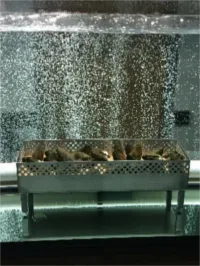Raman Microspectroscopic Analysis of Microplastic Particles in Biota Samples
Objectives
- Development of a digestion method for microplastic (MP) in bivalves
- Improvement of Raman microspectroscopic analysis of MP
- Description of MP uptake by bivalves in different exposure scenarios
Methods of Approach
- Raman microspectroscopy
- Acid digestion of tissue
Description
In the last century plastic became a valuable material, which is used in manifold applications. The increased demand led to a rising production of synthetic polymers. Since plastic is durable, it is supposed to accumulate in the aquatic environment over decades, where it can be disintegrated due to mechanical, photooxidative or microbiological influences. The resulting fragments are termed “microplastic (MP)” if their size is smaller than 5 mm. But not only marine environments are contaminated, recent studies suggest that limnic ecosystem contain MP in considerable amounts.
In order to estimate the influence of MP on limnic organisms, reliable identification methods are needed. One suitable method is Raman microspectroscopy (RM), which is based on the inelastic scattering of light. By means of RM MP particles down to 1 µm can be identified.
In our current project in cooperation with the Bavarian Environment Agency under funding of the Bavarian State Ministry of the Environment and Consumer Protection we focus on the uptake of MP by the indigenous bivalves Unio tumidus. First of all a digestion procedure for bivalve tissue for consequent RM analyses is improved and optimized. Furthermore purification steps are developed and an identification of MP in tissue of bivalves using RM is performed. We also focus on analyses of bivalves from different exposure scenarios as well as the development of a digestion method for fish tissue. The evaluation of MP in aquatic organisms in combination with results from toxicological investigations, will help to provide a realistic estimation of the potential harm of MP on aquatic organisms.

Publication
J. Domogalla-Urbansky1, P. M. Anger1, H. Ferling, F. Rager, A. C. Wiesheu, R. Niessner, N. P. Ivleva & J. Schwaiger, Raman microspectroscopic identification of microplastic particles in freshwater bivalves (Unio pictorum) exposed to sewage treatment plant effluents under different exposure scenarios. Environmental Science and Pollution Research 2018, doi.org/10.1007/s11356-018-3609-3 (1shared first authorship)
Posters
A. C. Wiesheu, F. Rager, P. M. Anger, H. Ferling, J. Domogalla-Urbansky, J. Schwaiger, R. Nießner, N. P. Ivleva, Identifikation von Mikroplastik in Süßwasserorganismen, Wasser 16, Bamberg, 2. – 4.05.2016
· P. M. Anger, A. C. Wiesheu, F. Rager, H. Ferling, J. Domogalla-Urbansky, J. Schwaiger, R. Niessner, N. P. Ivleva, Analysis of Microplastic Particles in Bivalve Samples, European Conference on Plastics in Freshwater Environments, Berlin, 21. – 22.06.2016
· A. C. Wiesheu, P. M. Anger, J. Domogalla-Urbansky, T. Geiger, H. Ferling, J. Schwaiger, R. Nießner, N. P. Ivleva, Mikroplastik in Frischwasserorganismen – Raman-mikrospektroskopische Untersuchungen, ANAKON 2017, Tübingen, 03. – 06.04.2017, Auszeichnung als bestes Poster
· A. C. Wiesheu, P. M. Anger, J. Domogalla-Urbansky, T. Geiger, H. Ferling, J. Schwaiger, R. Nießner, N. P. Ivleva, Identifikation von Mikroplastik in Süßwasserorganismen, Wasser 17, Donaueschingen, 22. – 24.05.2017